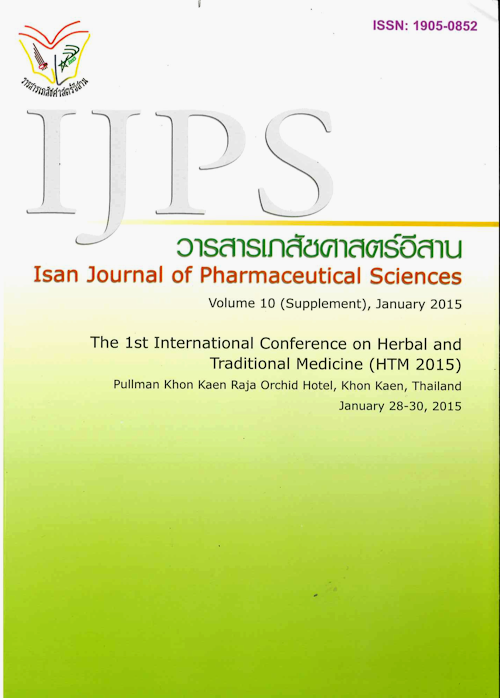Research and Development of Standardized Extract of Centella asiatica ECa 233
Main Article Content
Abstract
Introduction: The fact that a large variation of triterpenoids, including asiaticoside, madecassoside,
asiatic acid and madecassic acid, of Centella asiatica collecting from different parts of Thailand,
or at different time of the year does exist and that might pose a problem on accountability of the
herbal product for medical purpose. Objective: Thus, researchers at Faculty of Pharmaceutical Sciences,
Chulalongkorn University, aimed to establish a standardized extract of C. asiatica containing
consistent amount of its bioactive components. Methods: Step-by-step isolation guided by in vivo biological
activities in animal models was conducted to identify the bioactive molecules. Results: ECa
233, defined as a white to off-white extracted powder of C. asiatica containing triterpenoid glycosides
not less than 80% and the ratio between madecassoside and asiaticoside should be within 1.5 ± 0.5,
was successfully established. Preclinical evaluation in different animal models demonstrated that
orally given ECa 233 exerted gastro-protective effect as well as ameliorating effect on learning and
memory deficit. In addition, anxiolytic and analgesic effects were also observed. Topical application of
ECa 233 promoted wound healing process of both incision and burn wounds. In parallel with prominent
pharmacological effects, ECa 233 demonstrated favorable safety profiles in terms of acute toxicity,
sub-chronic toxicity as well as low potential to interact with other medications. Preliminary clinical trial
in human clearly demonstrated positive effect of ECa 233 on minor aphthous ulcers. Conclusion: ECa
233 is a well-characterized standardized extract of C. asiatica that should be further developed into
herbal products for medical use in human.
asiatic acid and madecassic acid, of Centella asiatica collecting from different parts of Thailand,
or at different time of the year does exist and that might pose a problem on accountability of the
herbal product for medical purpose. Objective: Thus, researchers at Faculty of Pharmaceutical Sciences,
Chulalongkorn University, aimed to establish a standardized extract of C. asiatica containing
consistent amount of its bioactive components. Methods: Step-by-step isolation guided by in vivo biological
activities in animal models was conducted to identify the bioactive molecules. Results: ECa
233, defined as a white to off-white extracted powder of C. asiatica containing triterpenoid glycosides
not less than 80% and the ratio between madecassoside and asiaticoside should be within 1.5 ± 0.5,
was successfully established. Preclinical evaluation in different animal models demonstrated that
orally given ECa 233 exerted gastro-protective effect as well as ameliorating effect on learning and
memory deficit. In addition, anxiolytic and analgesic effects were also observed. Topical application of
ECa 233 promoted wound healing process of both incision and burn wounds. In parallel with prominent
pharmacological effects, ECa 233 demonstrated favorable safety profiles in terms of acute toxicity,
sub-chronic toxicity as well as low potential to interact with other medications. Preliminary clinical trial
in human clearly demonstrated positive effect of ECa 233 on minor aphthous ulcers. Conclusion: ECa
233 is a well-characterized standardized extract of C. asiatica that should be further developed into
herbal products for medical use in human.
Article Details
Section
Invited Speaker
In the case that some parts are used by others The author must Confirm that obtaining permission to use some of the original authors. And must attach evidence That the permission has been included


